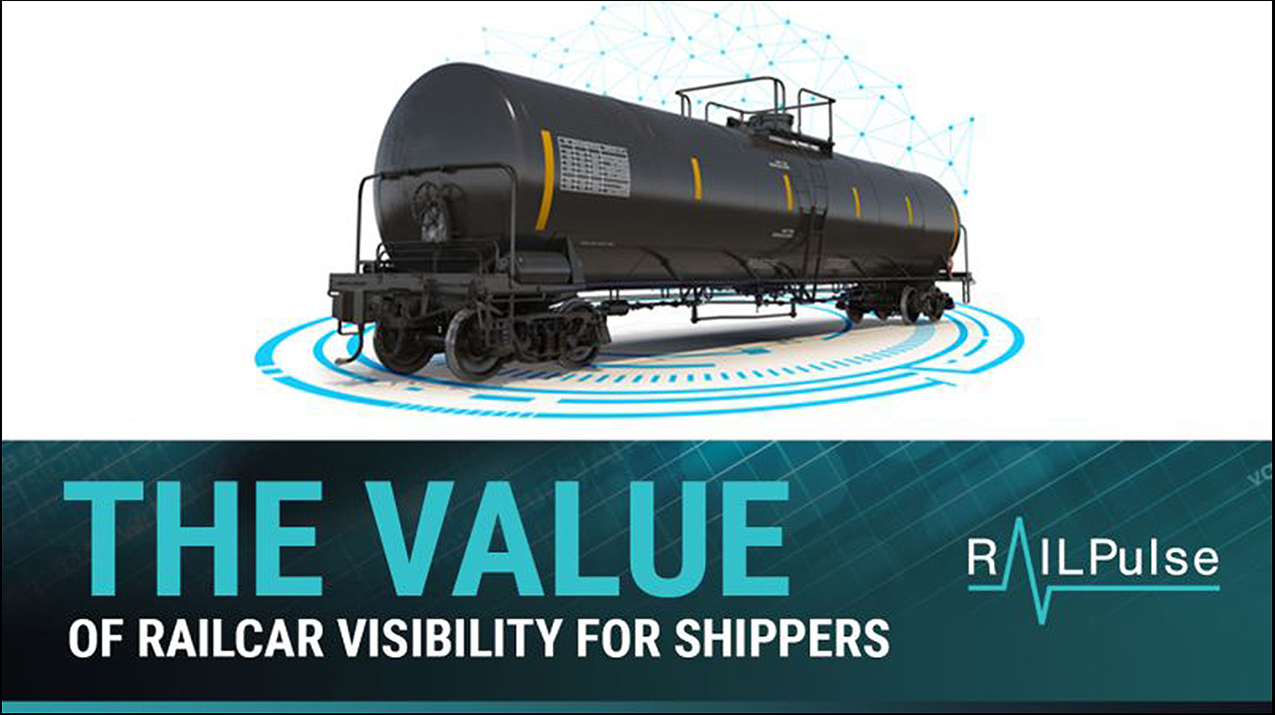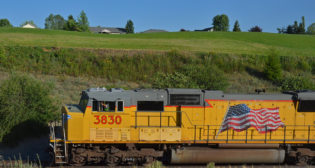
Finding the North American Railcar Fleet’s Pulse
Written by Kevin Smith, Editor-in-Chief, International Railway Journal
RailPulse is a cross-industry coalition of companies seeking to optimize the collection and use of data on freight car performance metrics to improve service on the North American rail freight network. Kevin Smith speaks with David Shannon, General Manager of RailPulse, about progress with this exciting initiative.
Part of the genius of Abraham Lincoln, one of the most revered of the Presidents of the United States, was his willingness to put differences aside for the good of the whole. Lincoln’s celebrated cabinet was a coalition of the president’s adversaries, often at odds with each other, but united under his stewardship to do what was best for the country in its most desperate hour.
The American freight railway industry in the 21st century, while not facing an American Civil War-level crisis, has experienced a worrying decline of its overall market share in the past couple of decades. Unfortunately, the at-best siloed, and at worst adversarial, structure of the industry has often been to the detriment of overall service quality and performance, resulting in some shippers slowly switching to other modes.

Recognizing the need for the sector to unite and stop the bleeding, in 2019 Michael McClellan, Senior Vice President and Chief Strategy Officer at Class I Norfolk Southern, brought together like-minded executives at short line operators Genesee & Wyoming and the Watco Companies, railcar leasing company GATX and railcar manufacturer, maintainer and lessor TrinityRail, which cumulatively own nearly 20% of the North American railcar fleet. Together the companies founded RailPulse in October 2020, with the intention of harnessing data from their respective fleets to improve overall asset and service performance.
RailPulse is not working to solely maximize profits for its founders but to grow rail traffic overall, which will benefit all parties in the long run. Each of the partners has an equal stake and an equal share of the business. No single party can take control to ensure it remains representative of the needs and objectives of the wider rail freight sector.
RailPulse’s strategy is focused specifically on the expansion of GPS technology and other telematics across the North American fleet to precisely determine the location, condition and health of these assets. The thinking is that improved understanding of these factors will help to drive up service quality and increase confidence among shippers to use rail, benefitting all parties involved.
The coalition quickly secured a $7.9 million grant from the U.S. Department of Transportation Consolidated Rail Infrastructure and Safety Improvements (CRISI) Program via the Pennsylvania Department of Transportation (PennDOT) to support their work to develop software systems and launch a large-scale pilot. PennDOT, alongside the founding partners, has also provided modest investment to support RailPulse’s early activities.

David Shannon was appointed General Manager of RailPulse in May 2022. Shannon, who has spent much of his career in telematics and vehicle tracking in various industries, is overseeing delivery of the pilot and will ultimately lead RailPulse’s transition into a commercial operation.
For the pilot project, the initial focus was on identifying potential telematics vendors. Of the around 100 that were found and assessed by RailPulse and an independent consultant, 20 were selected to participate in a Request for Information (RFI) exercise. A total of 10 responses were received, leading to the selection of three partner vendors for an initial year-long pilot project: Nexxiot, ZTR Control Systems and Hitachi Rail Systems, working in partnership with Intermodal Telematics.
Shannon reports that five key analytical measures were selected initially for the pilot: location via GPS; whether the handbrake is released, which is important to avoid accidental movements and potential damage to wheels; impact; the loaded/empty state of the railcar; and whether doors and hatches are open or closed. Crucially, RailPulse has moved away from the rail sector’s traditionally prescriptive approach to adopting new technology, where the industry has directly designed, specified and certified what it requires.
Shannon explains that the rail sector led the way with tracking assets with the introduction of barcodes and early RFID systems for railcars in the 1980s, technology the sector is still heavily reliant on 40 years later. In contrast, the trucking industry has allowed market forces to drive the adoption of new technologies for vehicle tracking, most recently the Internet of Things (IoT), which has slashed the cost of tracking while increasing the range of factors these companies are able to monitor. “We innovated and then froze,” Shannon says. “They innovated and kept innovating because they were not stuck to a rigid technology specification that became hardened.”
As well as stunting innovation, a prescriptive approach is also unlikely to be attractive to IoT suppliers due to the relatively small size of the market for the North American railcar fleet; 1.6 million assets might sound like a large number, but this in reality is quite small for an IoT application, even if a single supplier secured the entire market, Shannon says.
“We took the approach of being open to as many industry telemetry applicants who were willing to go through what we call RailPulse certification,” Shannon says. “What it prescribes is the interface that must exist between the vendor and RailPulse, the minimum standards on data frequency, data timeliness, quality and accuracy. And it prescribes a handful of specific outcomes a vendor must deliver to be certified. We’re not prescribing a sensor. We’re prescribing, for example, that you must be able to detect and deliver a load empty event, telling us that a railcar is loaded or empty at a minimum, and you must do it with high quality.
“How you determine if it’s loaded or empty, we don’t care. Be creative, be innovative, use your expertise as a vendor to build a better mousetrap. We don’t care about the mousetrap; we care about the outcome. And then as a vendor if you want to differentiate your product, and use that differentiation to help sell, you can overshoot our minimum requirement. And we will happily take the overshoot into the system.”
The Pilot
The pilot is divided into three phases. Initial work focused on limited tests of the proposed vendor technology in freight yards, which was extended in the second phase to main line testing. This has involved various railcar types ranging in age from new to 50 years old, all operating in the challenging North American rail freight environment of varying weather conditions and often harsh handling.
“We wanted to make sure that this technology, in principle, would work in practice in this very challenging environment,” Shannon says.
This work has been scaled up in the pilot’s final phase with around 2,200 railcars equipped with RailPulse technology currently in operation. The acquired data from these assets is also feeding the RailPulse software developed by the coalition in parallel to the testing program. A total of 12 companies who either own the wagons or are customers of these companies are now using the platform to monitor and record data on their assets, offering what Shannon describes as a “single source of truth” for the first time on location, health and condition of a single wagon.
“Instead of a shipper buying some hardware and sticking it on his consignment on a railcar, and then using that data against the railroad, or a railroad putting their own equipment on and using it against the shipper in a claim scenario, everyone is looking at the same data, and we have a single source of truth,” he says. “Provided you have the right to that data, you can get access either through an API to feed your own system or gain access through a RailPulse portal.”
Shannon reports that the solutions presented and deployed by the vendors across the five pilot scenarios have often used the same principles but with subtle differences in how they are measuring or collecting the data. Interestingly, many of these techniques have evolved throughout the process, according to Shannon, who says one vendor did a complete redevelopment of the architecture of how they were measuring some data points after realizing what they were doing was good, but not great.
“We’re working with all of them to say what we’re seeing and to make recommendations for changes, if the data is good or bad, or delivery is not as timely as it should be,” Shannon says.
As well as the vendors, RailPulse has signed a 10-year agreement with RailInc, the Association of American Railroads (AAR) subsidiary, to leverage its experience in managing vast volumes of data across the North American rail freight industry, as well as the experience of providing 24-hour customer support. RailInc is also supporting RailPulse to implement data management protocols, including data security, as well as to integrate railcar telematics device data into RailPulse’s backend systems. In addition, the agreement includes future data sharing arrangements. RailPulse will have access to RailInc’s railcar location message, waybill, and its Umler system, which offers critical data on more than 2 million items of North American rail, marine and highway equipment, enabling it to enhance its telematics data, which includes providing the capability to map telematics data to all parties in a given waybill route.
As the pilot steadily reaches its conclusion, Shannon says the plan is to “pull the wraps” off RailPulse in the second quarter of 2024, at which point it will be available as a commercial offer to any railcar owner who wants to participate.
The coalition has already grown from its five founding members to include another Class I, Union Pacific, railcar manufacturer The Greenbrier Companies, and short line operator Railroad Development Corporation (RDC) as well as the coalition’s first railcar-owning shipper, which is soon to be officially announced. Shannon says further discussions are under way with other prospective members, including two Class I’s, and two additional large railcar-owning shippers.
Along with coalition members, there are opportunities for additional vendors to come onboard. While the pilot vendors are continuing to invest to improve their capabilities to deliver better quality information, Shannon says they are getting “first mover advantage.” Others are still well placed to participate in the program. For example, a fourth vendor currently working through the RailPulse certification process is potentially very attractive to several of the coalition companies “because they are measuring the maintenance and health of a wheelset in a way that none of our existing vendors are,” Shannon says. “That is going to give them an opportunity to compete because they’re coming in with a very innovative solution that does all the stuff we require and then does things that a number of our customers are saying are really important additional features that they want.”
Ultimately, Shannon hopes that RailPulse becomes an “app store” where different providers can plug in their offer into a suite of services available to RailPulse users. “We’re not necessarily the creators of that IP,” Shannon says. “We’re providing the platform where value-added IP can be presented to customers so these producers can make money while driving the core goal of delivering better data to improve service to the shipper.”
The task of equipping the entire North American railcar fleet is obviously large but is the ultimate objective for the project. This will in the “long, long term,” as Shannon puts it, enable elimination of legacy technology such as a wayside detectors and change the whole structure of the railcar monitoring system on the North American network.
In the medium-term, Shannon says the priority is equipping the merchandise railcar fleet, and not intermodal, which he says mostly travels on unit trains that tend to run from point to point and are already equipped with a great deal of tracking equipment, nor hoppers or gondolas for carrying coal.
“We are looking at grains, metals, ores, box car cargo, paper, lumber, plastic pellets, tank car cargo–all the stuff that has the potential to shift between modes,” Shannon says. “We have set ourselves probably the hardest problem because that is where the greatest variety of cars is. We’ve got everything from gondolas to various flavors of covered hoppers, to centerbeam flats to regular flats to box cars of various and sundry types to autoracks. You name it, it’s there.”
Another key objective is to make joining RailPulse as frictionless as possible for the purchaser of a new railcar. Shannon says signing up should not be mandatory, but that the benefits of participating are so great that it becomes the default option.
How the recipients of the data ultimately use it is of course up to them. But Shannon believes that as railways become more comfortable with the platform, they are likely to change some of their operating practices to deliver better service. Equally, leasing companies and other fleet owners are likely to develop more creative maintenance strategies to keep asset quality high. There is also hope that shippers armed with better predictions of when empty and loaded railcars will arrive will turn those shipments around faster, helping to improve planning and provide a much more pleasant experience for the customer, helping rail to compete more effectively with road.
“Because they’re all using the same data, our belief is that will give us a more valuable outcome,” Shannon says.
There is certainly an element of excitement about RailPulse. Numerous speakers and delegates at Railway Interchange referred to its potential to improve service levels. How a diverse coalition had come together to find a solution that was right for the industry was especially noted. With just a few months until its official launch, the Team of Rivals behind RailPulse appears poised to deliver a new data-driven era for the North American rail freight industry. It might yet help to tilt the balance in its pursuit of modal share.



